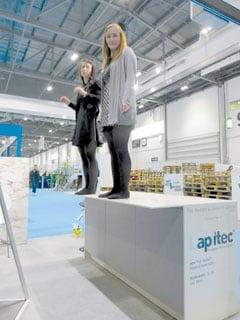Lapitec is a new generation of product from Breton that can expand the market for stone processors – and it is available now from The Marble & Granite Centre.
As the EcoBuild exhibition in London came to an end last month two women climbed up on to the Lapitec work surface being shown on the stand of the Marble & Granite Centre. The 12mm thick Lapitec had a 350mm unsupported overhang. The women walked to the edge of it and it supported their combined weight of 120kg.
It was an impressive demonstration of the new Breton material now in stock at the Marble & Granite Centre at Rickmansworth, Hertfordshire.
Stephen Pike, the Managing Director of the Marble & Granite Centre, whose background is steeped in natural stone, has never been an enthusiastic supporter of engineered quartz. He felt it never quite lived up to the claims made for it by those selling it. He has no such qualms about Lapitec.
This new weapon in the armoury in stone processors to help them win a larger share of a wider market is made by Breton, the same company that invented and sold the machines for making engineered quartz. This time it is keeping control of the manufacturing process itself and only selling the product. It is secretive about the process used to make the superdense, superstrong Lapitec and there are parts of the factory in the province of Treviso, in the north of Italy, that it does not allow visitors to see.
What it does say is that Lapitec is produced in a sintering process – the same process sometimes used for making diamond tools. It works by atomic diffusion and involves reducing the ingredients to a powder, compressing them and then firing them at a high temperature.
The exact minerals used in Lapitec is not being revealed, except to say they are 100% natural and that one of them is Titanium Dioxide, which is added to the material to make it pollution and mould resistant and anti-bacterial.
Atomic diffusion is something which occurs naturally through compression and heat and can take millions of years. Lapitec has managed to reduce this process to a few hours. The Lapitec ovens operate at 1200°C, but the material is capable of being handled as a sheet which can support its own weight even before it goes into the ovens.
The manufacturing process does not require binders such as the resins that hold engineered quartz together. As a result, Lapitec is inert and releases no VOCs (volatile organic compounds). Its colour is derived solely from minerals, rather than added chemicals, so will not fade. And at the end of its life it can be crushed and recycled as aggregate or simply sent to landfill. Even the factory where it is made has a roof of photovoltaic (solar) panels to produce green energy.
The research and development that has gone into Lapitec is extensive. Almost as soon as Breton had designed the machinery for engineering quartz in 1989 it started looking for the next generation of product.
What it did not want was something like porcelain that just has a decorated surface. It wanted a material akin to stone, with the pattern going throughout it, so it can be worked in the same way and on the same machines as stone – although it has required the production of diamond tools especially to work it and most of the tool makers now have, or are working on ranges especially for use with Lapitec. Some processors have decided the best way of cutting the increasing range of products is with waterjet technology (see NSS March issue).
The slabs are 3.4 x 1.5m in 12, 20 and 30mm thicknesses. They are currently available in 12 colours with a choice of four finishes called Lux (polished), Satin (honed), Vesuvio (leather) and Fossil, which is the most textured.
And because it is so strong, stable, resilient, light fast and practically impervious to water, Lapitec can be used with confidence for external cladding and paving as well as for interiors.

